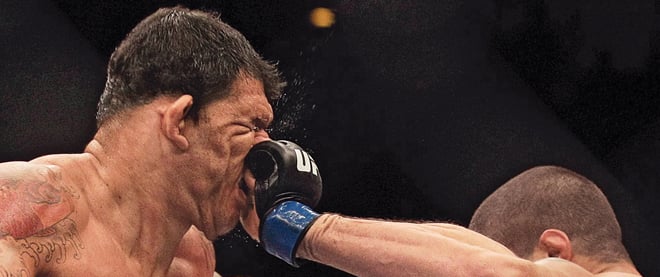Is MMA as dangerous as it looks?
Two Calgary trauma doctors who oppose the MMA ban want better data to know the true dangers
Felipe Dana/AP
Share

Horseback riding and mixed martial arts have little in common, except to Dr. Chad Ball. A few years ago, he conducted a study revealing how injured Canadian riders are different from those described by researchers in places such as New Zealand and Australia, where the typical patient is a young, inexperienced female practising English-style riding. In Canada, it is a man in his 40s with decades of western-style experience and a veteran horse. “Cowboys,” says Ball, a Calgary trauma surgeon. “They’re all over.”
So too are mixed martial arts fighters: Alberta has several promoters and leagues devoted to the full-contact combat sport, which combines boxing, wrestling and martial arts. The Ultimate Fighting Championship (UFC), which promotes MMA internationally, drew more than 55,000 fans to Toronto in April for a series of bloody matches. Knowing the sport’s popularity, and recalling how his equestrian study presented a different reality than previous research, Ball was skeptical when the Canadian Medical Association proposed banning MMA last year. Is this sport “savage and brutal,” like the CMA claims, or is it just perceived that way because the matches are gory? Is it really more dangerous than other sports, wondered Ball?
With this in mind, he and fellow surgeon Dr. Elijah Dixon wrote a response to the CMA published in the Canadian Journal of Surgery in February. They argue the proposal is based on “emotion, not evidence,” and note the dearth of long-term studies. The best data shows fighters get concussions in three per cent of matches, and a quarter of matches are stopped for head shots. At Foothills Medical Centre, where Ball and Dixon work, none of the eight trauma surgeons have admitted an MMA fighter—despite seeing 1,100 severely injured patients a year.
“The truth of the matter,” wrote Ball and Dixon, is that watching MMA “is viscerally uncomfortable.” But that’s no reason for a ban: “We suspect that if MMA were as visually pleasing as horseback riding, or as internationally accepted as rugby, or as financially substantial as professional football, there would be more acceptance of the sport.” Ball suspects the NHL is more risky than MMA: “I’d be willing to bet that the concussion and severe traumatic brain injury rate is higher,” he says, “yet we’re not banning hockey.”
Max Marin, owner of Canuckles MMA gym in Calgary, fought for 16 years before recently retiring. “I’ve snapped my knee, broken my jaw, my shin, my nose numerous times. I’ve only received one concussion.” Marin, 37, acknowledges the risks associated with fighting, but insists MMA is no worse than other sports. “You’d have to be ignorant not to feel danger,” he says, so “we have to approach things responsibly.”
Ball and Dixon have since requested data from the National Trauma Registry, a federal database, that they’ll sort through for MMA-specific injuries. This coincides with news that the UFC and the Cleveland Clinic will begin tracking MMA fighters to understand the health effects, too. For now, Ball encourages people to suspend judgment on MMA until there is better evidence—however hard that is to do.